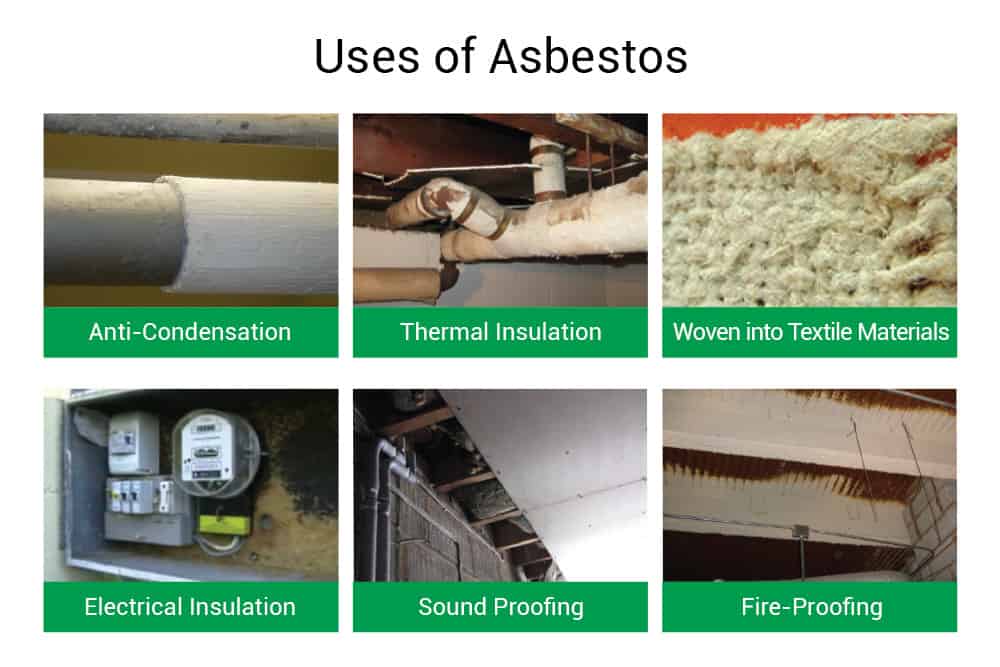
You are probably aware of the hazards of asbestos. Asbestos is a deadly carcinogen and all of its types can be hazardous. Inhaling asbestos fibres causes a range of fatal cancers and other diseases. Yet many people work in industries where they may still be exposed to it.
This makes it vital that you are able to identify asbestos if you come across it. But what does asbestos look like, and where might you find it? This article will look at the important answers to these questions.
A Long History of Use
One of the reasons it is still possible to encounter asbestos, is because it has been in use for many years. As far back as the late 1870s, asbestos was being used in the UK as a building material in ships, power plants and in steam engines. Although the significant health risks of asbestos were apparent by the early 1900s, asbestos was not fully prohibited until nearly a century later.
The Asbestos (Prohibitions) (Amendment) Regulations 1999 banned the use of asbestos in all forms. But, asbestos can still be found today in many buildings and products made before the year 2000.
What is Asbestos Used For?
Asbestos is an extremely versatile material with many useful properties. It has high tensile strength and is cheap and easily available. This is why it was widely used in a variety of industries.
It has been estimated that there are over 5,000 products that contain asbestos.
As mentioned, asbestos products, also called asbestos containing materials, or ACMs, are often found inside older buildings. ACMs can include insulation products, such as lining boards, insulation boards and exterior cladding panels. It was also used for roofing materials like artificial slates, asbestos ceiling tiles, roofing felt, fascia boards and guttering products.
But the level of risk of each of these products is not the same. It varies based on how easily asbestos fibres can be released from the ACM and the level of asbestos contained in that product.
But what does asbestos look like? Let’s consider some asbestos products and the levels of risk they present:

Bulk Loose Fill
Bulk loose fill was used as insulation in lofts, as firestop packing around cables, between floors and in cavity walls. In this form, it is usually pure asbestos. Loose fill insulation can have very high asbestos content, up to 100%.
Because the fibres are loose, they can easily become airborne if disturbed. This is a high-risk material and should only be handled by trained and licensed contractors.
Sprayed Coatings
Sprayed coatings were applied as anti-condensation, thermal and acoustic insulation. They were also used for fire protection. Such coatings might be found on the underside of roofs, the sides of industrial buildings and on reinforced concrete beams and columns.
Sprayed coatings usually contain between 55 to 85% asbestos. If they are unsealed, knocked or the surface is abraded, then they have a high risk of asbestos fibre release.
Thermal Insulation
Asbestos was widely used as thermal insulation in heating plants and equipment, including lining on boilers and pressure vessels and lining on pipework. In addition, the pipework itself can be made of asbestos.
Thermal lining was applied in a cement form, as well as in pre-formed pipe sections, slabs, or blocks. It was also applied to rope, corrugated paper, and blanket-type materials. The content of asbestos used in these applications varies considerably from 6 to 85%.
Insulating materials are usually covered with calico and painted with a sealant, such as PVA, latex or bitumen. This reduces the risk, provided the material is not disturbed. In such circumstances, they pose a medium risk of fibre release.
Asbestos Insulation Board
Asbestos insulation board, or AIB, was used for general heat insulation and fire protection. AIB is commonly found around radiators, in ceiling tiles, within fire doors and as building packing material. The asbestos content varies according to the type of AIB product.
‘Millboard’ was used for general heating insulation and fire protection and has between 37 and 97% asbestos.
Insulating board which was used in service ducts, firebreaks, infill panels, partitions and ceilings has 15 to 25% asbestos.
Insulating board used in fire doors and ceiling panels has between 16 and 64% asbestos.
AIB products usually pose a medium risk of fibre release, provided they are not disturbed or worked on, for example via drilling or sawing.
Asbestos Paper
Asbestos paper was used as an interior lining and as facing on flooring products. Asbestos paper can contain up to 100% asbestos
If the asbestos paper is encapsulated or combined within vinyl or bitumen, such as in surface linings and ceiling tiles, it typically poses a medium risk of fibre release.
Textile Materials
Asbestos was included in a wide range of textile materials. Ropes and yarns were used for jointing and packing. Rope was used as cladding on pipework and as electrical insulation, in fuse boards, for example.
The asbestos content of textile products is usually close to 100%. However, the weaving of the fibre in these products reduces the risk of fibre release. Provided they are not disturbed or worked on, these materials typically pose a low risk of fibre release.
Asbestos Cement
Asbestos was used extensively in products that were moulded or cast using cement. Common examples of asbestos cement, or AC, include roofing and cladding sheets, as well as moulded products, such as drainpipes, toilet cisterns, tanks and boiler flues. The asbestos content varies according to the type of product.
Profiled sheets used on roofs, for example, contain 10 to 15% asbestos.
Semi-compressed flat sheets that were used as infill panels in walls can contain 10 to 25% asbestos.
Fully compressed flat sheets that were used as roof slates or decking boards can contain up to 50% asbestos.
Pre-formed moulded products, such as toilet cisterns have a lower content and are typically comprised of 10 to 15% asbestos.
Asbestos cement products pose a low risk of fibre release provided the cement is not broken or abraded by, for example, sawing or drilling.
Decorative Coatings
Asbestos was used in textured decorative coatings such as paints and wall finishes. Well-known brand names for these products were ‘Artex’ and ‘Wondertex’.
Decorative coatings have a low asbestos content, usually between 3 and 5%.
The asbestos is well contained within the coating matrix and poses a low risk provided it is not machined by sanding or scraping the coating.
Bitumen and Adhesive Products
Asbestos can be found in bitumen products such as roofing felt. Mastics and adhesives were used in a wide range of building applications, including in the use of damp courses and gutter linings.
Bitumen products can contain up to 8% asbestos.
Adhesive products are lower, with up to 2% asbestos.
Provided they are not machined or damaged, these products pose a low risk of fibre release.
Flooring Products
Asbestos has been used in a wide range of flooring products, including floor tiles and stair nosings.
Flooring products, such as the asbestos floor tiles, can contain up to 25% asbestos. However, there is often a paper lining applied to the back surface which can contain 100% asbestos.
These products typically pose a low risk of fibre release provided they are not machined or damaged.
How to Know If a Material Contains Asbestos
It is difficult to know for certain if a material or product does or does not contain asbestos, and it is very difficult to answer the question what does asbestos look like? The only way you can be sure is to send a sample away to a laboratory and have it analysed under a microscope. If you are unsure, the best practice is to always assume that it does contain asbestos and act with extreme caution.
What Does Asbestos Look Like
In its raw state, asbestos has a variety of colours including green, blue, white and brown. You can find out more about the types of asbestos in our previous blog. However, after processing, asbestos is split into small soft fibres that, as we have seen, can be combined with other materials.
For this reason, it can be extremely difficult to identify ACMs by sight alone. Most commercial forms of asbestos have a fuzzy, fluffy texture and look like fairy floss or insulation. When broken, walls, flooring tiles or other products made with asbestos can often have visible strands of asbestos fibres.
Staying Safe Around Asbestos
If you encounter any materials that are broken or damaged and may contain asbestos, it is recommended to leave the area. Put up warning signs and alert a supervisor or a contractor that is licensed to work with asbestos and can remove it safely.
But, as we have shown, it can be difficult to answer the question of what does asbestos look like? This fact, combined with the abundance of asbestos that is still present in products and buildings across the UK, means that it is imperative to have professional, accredited asbestos safety training.
The training courses provided by Human Focus can be taken entirely online at your convenience. These training courses are certified by authorities such as the UK Asbestos Training Association (UKATA), and Independent Asbestos Training Providers (IATP). Human Focus courses provide employees and management with a full understanding of the risks posed by asbestos as well as in-depth training on appropriate safety measures.
































































































































































































































































































































































































































































































































































































































































































































































